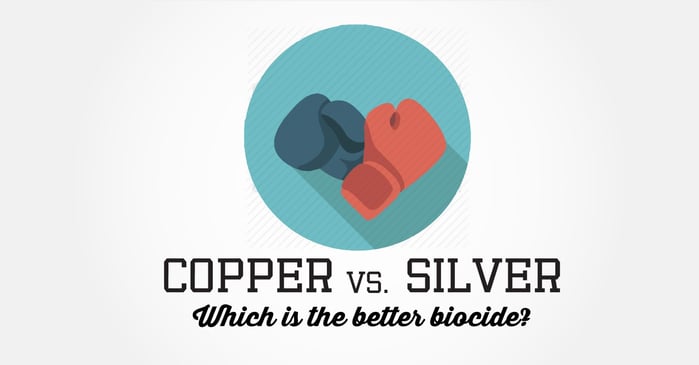 After considering a biocide's efficacy, toxicity, kill mechanisms, and bacterial resistance, one must also consider its cost. As with all criteria, it is an issue of balance. If it is an exceptionally effective, broad-spectrum biocide, then a higher cost is tolerable. Add in other benefits and a higher cost becomes even more reasonable. When it comes to silver and copper, the issue of cost in terms of raw materials is obvious. But to do our due diligence, we must look beyond just the raw materials and also look at cost vs. efficacy(and resulting return on investment from additional impact) to see the winner in a clearer light.
After considering a biocide's efficacy, toxicity, kill mechanisms, and bacterial resistance, one must also consider its cost. As with all criteria, it is an issue of balance. If it is an exceptionally effective, broad-spectrum biocide, then a higher cost is tolerable. Add in other benefits and a higher cost becomes even more reasonable. When it comes to silver and copper, the issue of cost in terms of raw materials is obvious. But to do our due diligence, we must look beyond just the raw materials and also look at cost vs. efficacy(and resulting return on investment from additional impact) to see the winner in a clearer light.
Cost
Both silver and copper are bought and sold on world markets, making their prices somewhat fluid. At the time of this post, the average price for silver is around $25/ounce, or $400/pound. The average price for copper is around $3.50/pound, less than 1% the price of silver. The relative cost of the metals means that to achieve the same level of biocidal activity in the same way (at the right concentrations), the cost of silver as a biocidal is far higher.
In addition, there are logistical issues with silver that further add to its high cost. Solid silver or silver alloy fixtures and surfaces present a serious threat for theft. A way that some manufacturers are trying to avoid this threat is by suspending silver particles in another medium. However, this presents a long-term cost concern, as silver ionic activity does not last indefinitely, requiring eventual replacement of biocidal materials at another large cost. Even the more cost-effective use of silver as a nanotechnology (minute particles of silver) has cost disadvantages, since it must be applied as a coating that must be periodically replenished. But most importantly, not one of these uses of silver is cost effective when considering its biocidal efficacy: Silver's requirement for moisture and high temperatures to be effective makes it an impractical, ineffective investment.
Who wins? Copper It comes down to humble, commonplace, ordinary copper. Not only is it far less expensive, copper is far more efficacious as a biocide. Which brings us to our final category, EPA Registration.
EPA Registration
When compared side-by-side along the critical areas we have covered in the past weeks, copper is the clear winner as a better biocide. Added to these criteria is one final advantage of copper: EPA-registration. Copper alloys as well as cuprous-oxide infused EOSCU Solid Surface are EPA-registered for public health claims. Silver can only claim to protect products from odor and mildew under what is caused a "treated article exemption," not the people who use them. This is a difference between preventing stinky socks and preventing a hospital-acquired infection. There really is no contest.
Who wins? Copper EPA Registration requires a 100% pass rate on tens of thousands of samples exposed to a broad spectrum of organisms under extreme conditions (far more extreme than typical hospital conditions.) The only solid surfaces to complete these tests, killing greater than 99.9% of bacteria in under two hours, are copper alloys and EOSCU Solid Surface.
Check out our handy infographic comparing silver and copper with all the key facts from each post in this series.
Editor's Note: This post was originally published in October 2015 and has been updated for freshness, accuracy and comprehensiveness.

